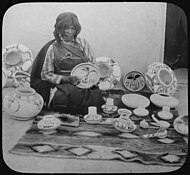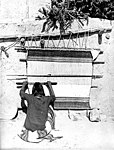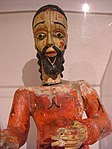

Art of the American Southwest is the visual arts of the Southwestern United States. This region encompasses Arizona, New Mexico, and parts of California, Colorado, Nevada, Texas, and Utah. These arts include architecture, ceramics, drawing, filmmaking, painting, photography, sculpture, printmaking, and other media, ranging from the ancient past to the contemporary arts of the present day.
Historic influences
Ancient Puebloan people
The Ancestral Puebloans, or Anasazi (up to 1400 CE) are the ancestors of today's Pueblo tribes. Their culture formed in the American Southwest after the cultivation of corn was introduced from Mesoamerica about 4,000 years ago. People of this region developed an agrarian lifestyle and lived in sedentary towns.
Common early pottery included corrugated gray ware pottery and decorated black-on-white pottery. Corrugated pottery was made from coils of clay wound into the desired shape and the clay is pinched, which created the corrugated texture. White on black evolved as a decorative pottery and was often used as a trade good for food. Sikyátki, a former Hopi village in Arizona inhabited from the 14th through the 16th centuries, is the source of polychrome pottery. Around 300 CE the Hohokam culture developed in Arizona. They are the ancestors of the Tohono O'odham and Akimel O'odham or Pima tribes. The Mimbres, a subgroup of the Mogollon culture, are especially notable for the narrative paintings on their pottery.
-
 Ancestral Pueblo olla, Cibola Whiteware, northeast Arizona
Ancestral Pueblo olla, Cibola Whiteware, northeast Arizona
-
 Anasazi bowl (trade ware) dating from 900-1100 AD, excavated at Chaco Culture National Historical Park
Anasazi bowl (trade ware) dating from 900-1100 AD, excavated at Chaco Culture National Historical Park
-
 Mimbres Bowl with rabbit, AD 1000–1150
Mimbres Bowl with rabbit, AD 1000–1150
-
 Sikyátki dragonfly bowl, about 1400-1625 AD
Sikyátki dragonfly bowl, about 1400-1625 AD
Turquoise, jet, and spiny oyster shell have been traditionally used by Ancestral Pueblo for jewelry, and they developed sophisticated inlay techniques centuries ago. The Ancestral Puebloans (Anasazi) of the Chaco Canyon and surrounding region are believed to have prospered greatly from their production and trading of turquoise objects.
Native American nations
Within the last millennium, Athabaskan peoples emigrated from northern Canada in the southwest. These include the Navajo and Apache. Sandpainting is an aspect of Navajo healing ceremonies that inspired an art form. Navajos learned to weave on upright looms from Pueblos and wove blankets that were eagerly collected by Great Basin and Plains tribes in the 18th and 19th centuries. After the introduction of the railroad in the 1880s, imported blankets became plentiful and inexpensive, so Navajo weavers switched to producing rugs for trade.
Pueblo, Navajo and Apache tribes cherished turquoise for its amuletic use; the latter tribe believe the stone to afford the archer dead aim. Among these peoples turquoise was used in mosaic inlay, in sculptural works, and was fashioned into toroidal beads and freeform pendants. The distinctive silver jewelry produced by the Navajo and other Southwestern Native American tribes today is a rather modern development, thought to date from c. 1880 as a result of European influences.
Colonial Spanish
With a need to be self-sufficient, many Hispanic people woodworking, weaving, tinsmith, farming and leather work skills to create the furniture and furnishings for their homes.
Anglo-Americans
Ancient artistic traditions have been manifested in native craft for generations when Europeans began to settle in the American Southwest; an important acknowledgement for understanding the inherent aesthetic allure of this area to the Anglo-American artists.
Integration of influences
Silverworking was adopted by native Southwest artists beginning in the 1850s, when Mexican silversmiths had to trade their silverwork for cattle from the Navajo. The Zuni admired the silver jewelry made by the Navajos, such as Atsidi Sani (Old Smith), so they began trading livestock for instruction in working silver. By 1890, the Zuni had taught the Hopi how to make silver jewelry.
Native Americans were also influenced by the introduction of paintings made with oil and watercolor on canvas, where they traditionally painted objects such as hides or inside buildings, such as on the walls of a kiva. The Native American paintings provided artwork that was realistic of the Native American lifestyle in contrast to the work of Anglo-Americans romantic depictions. Traditional design elements were formalized at the Studio at the Santa Fe Indian School, defining flatstyle Native American art. The Studio was developed in 1932 by Dorothy Dunn, who taught there until 1932, and was replaced by Geronima Cruz Montoya (Ohkay Owingeh), who taught art at the Studio until its closing in 1962, when the Institute of American Indian Arts was established.
Following World War I, the completion of the Santa Fe Railroad enabled American settlers to travel across the west, as far as the California coast. New artists’ colonies started growing up around Santa Fe and Taos, the artists' primary subject matter being the native people and landscapes of the Southwest. Images of the Southwest became a popular form of advertising, used most significantly by the Santa Fe Railroad to entice settlers to come west and enjoy the “unsullied landscapes”. Walter Ufer, Bert Geer Phillips, E. Irving Couse, William Henry Jackson, and Georgia O'Keeffe are some of the more prolific artists of the Southwest.
Basketry
Native Americans, including those of the American Southwest, traditionally make their baskets from the materials available locally.
-
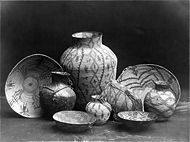 Apache basketry bowls and ollas, photo by Edward S. Curtis
Apache basketry bowls and ollas, photo by Edward S. Curtis
-
Hopi coiled basket, c. 1901, Ethnologischen Museum, Berlin-Dahlem
-
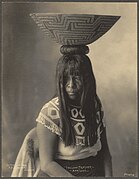 Yellow Feather (Maricopa), c. 1898, photo by Frank A. Rinehart
Yellow Feather (Maricopa), c. 1898, photo by Frank A. Rinehart
-
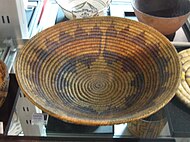 Navajo basket, Museum of Anthropology, Vancouver, BC, Canada
Navajo basket, Museum of Anthropology, Vancouver, BC, Canada
-
 Luzi (Tohono O'odham) with coiled burden basket, with a supporting ring of yucca, photo by Edward S. Curtis
Luzi (Tohono O'odham) with coiled burden basket, with a supporting ring of yucca, photo by Edward S. Curtis
-
 Yavapai flat, coiled willow basket, Stanford University
Yavapai flat, coiled willow basket, Stanford University
Pottery
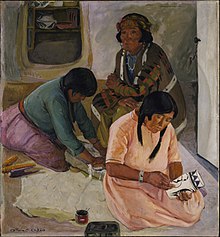
Acoma pottery
Acoma pottery, beginning over 1,000 years ago, traditional designs include thunderbirds, geometric patterns, and rainbows. The pottery is made of fine local clay found on the pueblo to create the distinctively thin-walled pottery. The pottery is made in white and black and polychrome colors. Designs are pressed into all-white pottery with a fingernail or tool. Potters from Acoma Pueblo during the 1950s include Marie Z. Chino and Lucy M. Lewis. Vera Chino Ely, the daughter of Marie Chino, is also a well-reputed potter of Acoma pottery.
-
 Acoma Black-on-white olla, Lucy M. Lewis, c. 1960–1970s, Fred Jones Jr. Museum of Art collection
Acoma Black-on-white olla, Lucy M. Lewis, c. 1960–1970s, Fred Jones Jr. Museum of Art collection
-
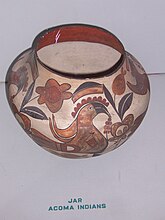 Acoma Pueblo polychrome jar, Field Museum of Natural History
Acoma Pueblo polychrome jar, Field Museum of Natural History
Hopi pottery
In historical times, Hopi created ollas, dough bowls, and food bowls of different sizes for daily use, but they also made more elaborate ceremonial mugs, jugs, ladles, seed jars and those vessels for ritual use, and these were usually finished with polished surfaces and decorated with black painted designs. Creating pottery is a social activity for the Hopi tribe. Potters who work closely together share production skills and marketing knowledge. Children are encouraged to play with clay, but in adulthood the decision to take up pottery is a sign of "strength, maturity and patience." At the turn of the 20th century, Hopi potter Nampeyo revived Sikyatki-style polychrome pottery from the 14th to 17th centuries.
In the late 20th century, Hopi-Tewa potter Paqua Naha from First Mesa, followed by her daughter Joy Navasie, Helen Naha "Feather Woman", and their children achieved international recognition for their traditionally made Hopi pottery.
Santa Clara pottery
Santa Clara pottery is distinguished for its red polychrome and shiny black pottery. It is also known for the having designs carved into the clay when the piece has dried to "leather hard."
San Ildefonso pottery
San Ildefonso pottery in noted for the black-on-black pottery brought to the San Ildefonso Pueblo in the early 20th century by Maria Martinez and her husband Julian Martinez when they rediscovered how to make the pottery.
-
 Maria and Julian Martinez matte-on-glossy blackware wedding vase, c. 1929, collection of the Fred Jones Jr. Museum of Art
Maria and Julian Martinez matte-on-glossy blackware wedding vase, c. 1929, collection of the Fred Jones Jr. Museum of Art
-
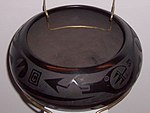 Black-on-Black pottery of the pueblo. Artifact at the Field Museum, Chicago.
Black-on-Black pottery of the pueblo. Artifact at the Field Museum, Chicago.
Taos pottery
Juanita Suazo Dubray, a lifelong resident of Taos Pueblo, is a Native American potter who makes micaceous pottery, upholding the tradition of her mother and their ancestors. Dubray added an element of sculptural relief with icons of corn, turtles, lizards, and kiva steps in relief.
Zuni pottery
Zuni pottery is made from local clay which receives a ritualistic vow of thanks before it is gathered. It is painted with home-made organic dyes, using a traditional yucca brush. The intended function of the pottery dictates its shape and images painted on its surface. Firing of the pottery was usually a community enterprise, silence or communication in low voices was considered essential in order to maintain the original "voice" of the "being" of the clay, and the purpose of the end product. Sales of pottery and traditional arts provide a major source of income for many Zuni people today. An artisan may be the sole financial support for her immediate family as well as others.
-
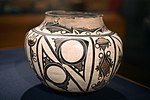 Zuni olla, late 19th or early 20th century, 12.5" high, Brooklyn Museum.
Zuni olla, late 19th or early 20th century, 12.5" high, Brooklyn Museum.
-
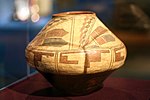 Zuni Ashiwi Polychrome Water Jar, 1700-1750, 11 1/4 x 13 1/4 x 13 1/4 in. Brooklyn Museum.
Zuni Ashiwi Polychrome Water Jar, 1700-1750, 11 1/4 x 13 1/4 x 13 1/4 in. Brooklyn Museum.
Textiles
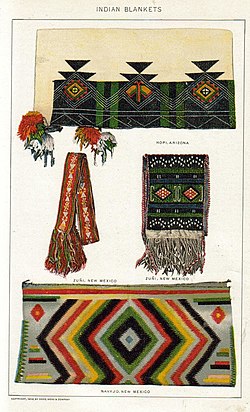
Dr. Joe Ben Wheat examined thousands of 19th-century textiles, with the goal of establishing "a key for southwestern textiles identification based on the traits that distinguish the Pueblo, Navajo, and Spanish American blanket weaving traditions and provide a better way of identifying and dating pieces of unknown origin.” The years of research resulted in the "groundbreaking" publication of "Blanket Weavings in the Southwest".
Navajo weaving
Main article: Navajo weavingNavajo textiles, such as handwoven blankets and rugs, are highly regarded, valued for over 150 years, and an important element of the Navajo economy. Navajo textiles were originally utilitarian blankets for use as cloaks, dresses, saddle blankets, and similar purposes. Toward the end of the 19th century, weavers began to make rugs for tourism and export. Typical Navajo textiles have strong geometric patterns. They are a flat tapestry-woven textile produced in a fashion similar to kilims of Eastern Europe and Western Asia, but the warp is one continuous length of yarn and does not extend beyond the weaving as fringe.
-
 Navajo warp in progress. Source: John Hritz.
Navajo warp in progress. Source: John Hritz.
-
 Navajo blankets in the Hubbell Trading Post National Historic Site Ganado, Arizona
Navajo blankets in the Hubbell Trading Post National Historic Site Ganado, Arizona
-
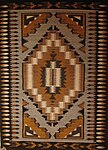 Navajo Rug Source: Teofilo
Navajo Rug Source: Teofilo
Hopi weaving
Figures
Bultos
Bultos are three-dimensional, hand-carved religious figures, often of saints, introduced by the Spanish-Mexicans.
Fetishes
Main articles: Fetishes and Zuni fetishesHand-carved or naturally formed fetishes that are believed to hold spiritual forces specific to certain animals and have been commonly used in Native American religion and practices. The bear represented the shaman, the buffalo was the provider, the mountain lion was the warrior, and the wolf was the pathfinder.
Frank Hamilton Cushing's publication Zuni Fetishes describes the Zuni world made up of six regions or directions. At the center of each region is a great mountain peak that is a very sacred place. Yellow mountain to the north, blue mountain to the west, red mountain to the south, white mountain to the east, the multi-colored mountain above, and the black mountain below. Each direction is represented by a "Prey God", or guardian animal each having protective or healing powers, and are listed by Cushing as follows: north - the mountain lion, south – the badger, east – the wolf, west – the black bear, the sky or upper – the multi-colored eagle, and the underground or lower – the black mole."
Kachina dolls
Main article: Hopi Kachina dollsKachina images appeared in murals in kivas, pictographs and petroglyphs of Puebloan people by AD 1300. The Kachina religion was foundational for modern Zuni and Hopi people.
Zuni and Hopi Kachina dolls are representations of spiritual beings. Hand carved kachina dolls are given to the young girls as gifts given by the Kachina dancers during Kachina ceremonies. 19th century dolls carved with minimum modern tools were finished with abrasive stones and polished smooth with kaolin clay and then painted with natural dyes. Zuni kachinas are believed to live in remote northeastern Arizona and bring life by giving rain and additional support, such as promote success for hunters and farmers, combat depletion of fur-bearing animals over the 19th and 20th centuries, or influence peoples' prosperity or well-being.
There are more than 400 different kachinas in Hopi and Pueblo culture. The local pantheon of kachinas varies in each pueblo community; there may be kachinas for the sun, stars, thunderstorms, wind, corn, insects, and many other concepts.
-
 Kachina doll (fetish) of a Koshare, c. 19th century, private collection.
Kachina doll (fetish) of a Koshare, c. 19th century, private collection.
-
 Drawings of kachina dolls, from an 1894 anthropology book.
Drawings of kachina dolls, from an 1894 anthropology book.
Kokopelli
Main article: KokopelliKokopelli is a hunchbacked flute player who represents the spirit of music and is a Native American fertility deity, sometimes depicted with a phallus, who presides over childbirth and agriculture. Kokopelli is one of the most easily recognized figures found in the petroglyphs and pictographs of the Southwest, the earliest known petroglyph is dated about A.D. 1000. He is often featured in rituals relating to marriage, and Kokopelli himself is sometimes depicted with a woman called Kokopel Mana by the Hopi. Kokopelli chases away winter and brings about the warmth and rains of spring with his flute playing. Among the Hopi, Kokopelli carries unborn children on his back and distributes them to women. His image has been used in rock art, pottery, kachina dolls and more.
-
 Kokopelli petroglyph, BLM land near Embudo, New Mexico.
Kokopelli petroglyph, BLM land near Embudo, New Mexico.
-
 Kokopelli.
Kokopelli.
-
 Phallic Kokopelli
Phallic Kokopelli
-
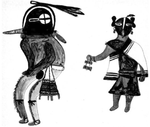 Kokopelli and Kokopelli Mana
Kokopelli and Kokopelli Mana
Dolls and toys

Navajo dolls were made by Navajo women based upon full dresses worn by east coast American women in the 1860s. Velvet was substituted for the satin and buttons were made out of nickels and dimes.
Storyteller dolls
Main article: Storyteller dollStoryteller doll is a clay figure surrounded by figures of listening children made by the Pueblo people of New Mexico. The first storyteller doll was made by Helen Cordero of the Cochiti Pueblo to honor of her grandfather, a tribal storyteller.
Sculpture
-
 For Life in all Directions, bronze sculpture by Roxanne Swentzell (Santa Clara Pueblo), NMAI
For Life in all Directions, bronze sculpture by Roxanne Swentzell (Santa Clara Pueblo), NMAI
Jewelry
Main article: Native American jewelry § SouthwestTurquoise, red spiny oyster, and jet have been used in jewelry in the southwest for centuries. Silverwork was introduced through trade in the 19th century, and Atsidi Sani became the Navajo silversmith around 1853. Silversmithing technologies rapidly spread to other tribes. Southwest silverwork includes designs of channel inlay, cluster, mosaic, and petite point and materials of shell, gemstones and beads. While the Navajo favored the squash blossom necklace, they often also combined turquoise, coral, and other semi-precious gemstones. Stones were set into silver scrolls, leaf patterns, and strung on cord for necklaces.
Hopi are renowned for their overlay silver work, developed in the 1940s. Zuni artists are admired for their cluster work jewelry, showcasing turquoise designs, as well as their elaborate, pictorial stone inlay in silver.
Beadwork
-
 Hohokam turquoise mosaics, found in 1925 in Casa Grande Ruins National Monument, Arizona
Hohokam turquoise mosaics, found in 1925 in Casa Grande Ruins National Monument, Arizona
-
 Apache beadloom
Apache beadloom
-
 Apache beaded hide bag, Oklahoma History Center
Apache beaded hide bag, Oklahoma History Center
-
 Mojave woman's beaded collar, c. 1930s–1940s, Heard Museum
Mojave woman's beaded collar, c. 1930s–1940s, Heard Museum
-
 Ute beadwork
Ute beadwork
Silverwork
-
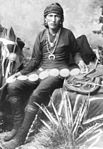 Bai-De-Schluch-A-Ichin or Be-Ich-Schluck-Ich-In-Et-Tzuzzigi "Metal Beater" (Slender Silversmith, Navajo) with silver necklaces, concho belts, and tools, 1883
Bai-De-Schluch-A-Ichin or Be-Ich-Schluck-Ich-In-Et-Tzuzzigi "Metal Beater" (Slender Silversmith, Navajo) with silver necklaces, concho belts, and tools, 1883
-
 old and new Navajo bracelets with turquoise
old and new Navajo bracelets with turquoise
-
 Pueblo necklace with turquoise heishe-style beads, early 20th century, Walters Art Museum
Pueblo necklace with turquoise heishe-style beads, early 20th century, Walters Art Museum
-
 Navajo squash blossom necklace with naja pendant
Navajo squash blossom necklace with naja pendant
-
 Silver overlay bolo tie, by Tommy Singer (Navajo)
Silver overlay bolo tie, by Tommy Singer (Navajo)
Spanish tinwork
Tinware, likely introduced from Mexico and Spain, was used for religious adornments and household objects, such as sconces and mirrors and became increasingly popular in the mid-19th century.
Two-dimensional art
Paintings
-
 Hide painting by Naiche (Chiricahua Apache), c. 1900, depicting an Apache girl's puberty ceremony, Oklahoma History Center
Hide painting by Naiche (Chiricahua Apache), c. 1900, depicting an Apache girl's puberty ceremony, Oklahoma History Center
-
 Chiricahua or Western Apache handpainted playing cards, c. 1875-1885, rawhide, Arizona, National Museum of the American Indian
Chiricahua or Western Apache handpainted playing cards, c. 1875-1885, rawhide, Arizona, National Museum of the American Indian
Santos
Santos, developed in the late 17th century, are religious icons painted on a flat board (retablos) or carved out of wood (bultos).
Exhibitions and institutions
Many annual art events showcase Southwestern art. The Southwestern Association for Indian Arts hosts Indian Market every August in Santa Fe, New Mexico, which began in 1922. Also begun is 1922 is the Gallup Inter-Tribal Indian Ceremonial which features a juried art show and art market, as well many other events, in Gallup, New Mexico. The Heard Museum Guild has held their Indian Art Fair since 1958 in Phoenix, Arizona. The Arizona State Museum on the University of Arizona in Tucson hosts the annual Southwest Indian Art Fair, and the Museum of Northern Arizona in Flagstaff and host major art's festivals for Southwest indigenous and Hispanic peoples. The Santa Fe Spanish Market hosts two annual events, a December Winter Market of experimental Hispanic arts, and a July Spanish Market, showcasing classical Hispanic arts, such as santos, retablos, staw appliqué (popotillo), colcha embroideries, tinwork, ramilletes, and other media.
See also

Communities
- Taos art colony, New Mexico
- Puebloan peoples
- Acoma Pueblo, New Mexico
- San Ildefonso Pueblo, New Mexico
- Santa Clara Pueblo, New Mexico
- Taos Pueblo, New Mexico
- Zuni Pueblo, New Mexico
Events
Museums
- Albuquerque Museum of Art and History, New Mexico
- Amerind Foundation, Arizona
- Anasazi Heritage Center, Colorado
- Heard Museum of Native Cultures and Art, Arizona
- Hopi Cultural Center, Arizona
- Indian Pueblo Cultural Center, New Mexico
- Institute of American Indian Arts, New Mexico
- Millicent Rogers Museum, New Mexico
- Museum of Indian Arts and Culture, New Mexico
- Museum of Northern Arizona, Arizona
- Phoenix Art Museum, Arizona
- Southwest Museum of the American Indian, California
- Wheelwright Museum of the American Indian, New Mexico
Notes
- Southwestern United States Free Dictionary. Retrieved January 18, 2012.
- Pritzker, pp. 3-4
- Pueblo Indian History. Archived 2011-10-08 at the Wayback Machine Crow Canyon Archaeological Center. Retrieved 10-9-2011.
- Ancestral Puebloan Chronology (teaching aid). Mesa Verde National Park, National Park Service. Retrieved 10-16-2011.
- ^ "Ancestral Hopi Pottery." Archived 2008-02-08 at the Wayback Machine Arizona State Museum. 2007 (retrieved 14 Aug 2010)
- Stuart, David E.; Moczygemba-McKinsey, Susan B. (2000) Anasazi America: Seventeen Centuries on the Road from Center Place. University of New Mexico Press. p. 57. ISBN 0-8263-2179-8.
- Ancestral Hopi Pottery. Archived 2008-02-08 at the Wayback Machine Arizona State Museum, University of Arizona. Retrieved January 17, 2012.
- ^ Pritzker, p. 4
- Waldman, Carl. (2006) . Encyclopedia of Native American tribes. New York: Infobase Publishing. pp. 2-3. ISBN 978-0-8160-6274-4.
- Brody et al, p. 9.
- "Hispanic Arts and Crafts". Collections. Millicent Rogers Museum. Archived from the original on 2010-11-25. Retrieved 2011-06-02.
- "Artists of the Taos Pueblo". Taos Pueblo. Retrieved 2011-05-29.
- ^ Witt, D (2003). "Three Taos Pueblo Painters". Traditional Fine Art Online, Inc. Archived from the original on 2011-07-03. Retrieved 2011-05-30.
- ^ Hewett, Edgar. Native Peoples of the American Southwest. 1968
- Bernstein and Rushing, p. 14
- David Zax (2008). "Ancient Citadel". Archived 2012-01-30 at the Wayback Machine Travel. Smithsonian Magazine. Retrieved January 18, 2012.
- Casey, Robert. L. (1993) . High Journey to the Southwest. The Globe Pequot Press. p. 298. ISBN 1-56440-151-0.
- "Form and Meaning in Indigenous Aesthetics: A Hopi Pottery Perspective". American Indian Art Magazine. 32. Autumn 2007.
- Pecina 163
- Santa Clara Pueblo. National Park Service. Retrieved January 16, 2012.
- Suazo Dubray. Through the Eyes of the Pot, Artists. L. D. Holmes Museum.
- Anderson, D. (1999). "All That Glitters: The Emergence of Native American Micaceous Art Pottery in Northern New Mexico." School of American Research Press. p. 62.
- Morrell, Virginia. "The Zuni Way ." Archived 2013-09-05 at the Wayback Machine Smithsonian Magazine. April 2007 (retrieved 13 Feb 2011)
- Jesse Green, ed. Zuni: Selected Writings of Frank Hamilton Cushing. Lincoln: University of Nebraska Press, 1979. ISBN 0803270070
- Wheat, J.B. (2003) Blanket Weaving in the Southwest, edited by Ann Lane Hedlund, Tucson, AZ, University of Arizona Press.
- University of Arizona. The Books. The University of Arizona Press. Tucson Arizona. Retrieved March 31.
- Mauer, Evan M. Maurer. (1986). "Determining Quality in Native American Art" in The Arts of the North American Indian: Native Traditions in Evolution. New York: Philbrook Art Center. p. 150.
- Durham, Michael S. (1990). The Smithsonian Guide to Historic American: The Desert States. New York: Steart, Tabori & Chang. p. 164. ISBN 1-55670-109-8.
- ^ Casey, Robert. L. (1993) . High Journey to the Southwest. The Globe Pequot Press. p. 419. ISBN 1-56440-151-0.
- "Animals: fact and folklore," New Mexico Magazine, August 2008, pp. 56-63.
- ^ Indian Fetishes: Southwest tribal miniature carvings that some say are imbued with spirit forces. The Collector's Guide. Retrieved January 17, 2012.
- Ancestral Pueblo - Pueblo IV. Archived 2014-09-03 at the Wayback Machine Anthropology Laboratories of the Northern Arizona University. Retrieved 10-12-2011.
- Ancient Farmers. Petrified Forest National Park, National Park Service. Retrieved 10-16-2011.
- Pecina, Ron and Pecina, Bob. Hopi Kachinas: History, Legends, and Art. pp20-21;34; Schiffer Publishing Ltd., 2013. ISBN 978-0-7643-4429-9
- "Millicent Rogers Museum". Taos Museums. Museum Association of Taos. Archived from the original on 2011-08-30. Retrieved 2011-06-02.
- "Kachina". Collection. Millicent Rogers Museum. Archived from the original on 2010-11-25. Retrieved 2011-06-02.
- Wright, Barton; Roat, Evelyn. (1965). "This is a Hopi Kachina." Museum of Northern Arizona. p. 4.
- Young, John V. (1990). Kokopelli: Casanova of the Cliff Dwellers; The hunchbacked flute player. Filter Press. pp. 18. ISBN 9780865410268.
- Welker, Glenn. "Kokopelli Legends & Lore". Indigenous Peoples Literature. 1993-2008. Retrieved January 18, 2012.
- Larson, Jack Lenor. (1995). Folk Art from the Global Village. Santa Fe, NM: Museum of New Mexico Press.
- "Helen Cordero (1915- )." AskArt. Retrieved 11 April 2012.
- "Tinwork". Collections. Millicent Rogers Museum. Retrieved 2011-06-02.
- "Santos". Collections. Millicent Rogers Museum. Archived from the original on 2010-12-18. Retrieved 2011-06-02.
- "Southwestern Association for Indian Art." Retrieved 12 April 2012.
- "Gallup Inter-Tribal Indian Ceremonial." Archived 2012-03-26 at the Wayback Machine New Mexico. Retrieved 12 April 2012.
- "Learn about the Fair." Archived 2012-04-13 at the Wayback Machine Arizona State Museum. Retrieved 12 April 2012
- "Heritage Program Festivals." Archived 2012-03-12 at the Wayback Machine Museum of Northern Arizona. Retrieved 12 April 2012.
- "Spanish Market." Archived 2012-03-27 at the Wayback Machine New Mexico. Retrieved 12 April 2012.
References
- Bernstein, Bruce, and W. Jackson Rushing. (1995). Modern by Tradition: American Indian Painting in the Studio Style. Santa Fe: Museum of New Mexico Press. ISBN 0-89013-291-7.
- Brody, J. J., Catherine J. Scott, Steven A. LeBlanc. (1983). Mimbres Pottery: Ancient Art of the American Southwest: Essays. American Federation of Arts. ISBN 0-933920-46-6.
- Pritzker, Barry M. (2000). A Native American Encyclopedia: History, Culture, and Peoples. New York: Oxford University Press. ISBN 0-19-513877-5.
- Pecina, Ron and Pecina, Bob. Hopi Kachinas: History, Legends, and Art. pp163-167. Schiffer Publishing Ltd., 2013. ISBN 978-0-7643-4429-9
